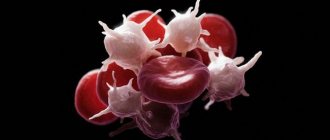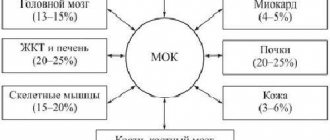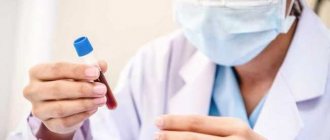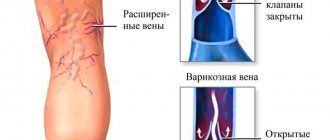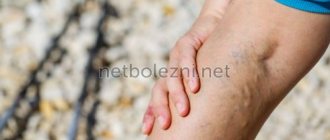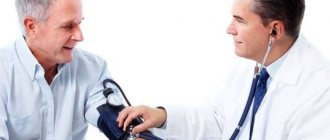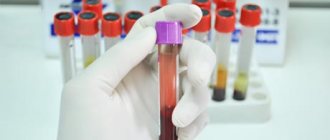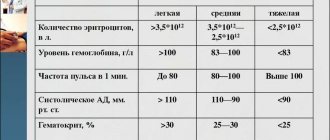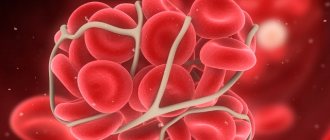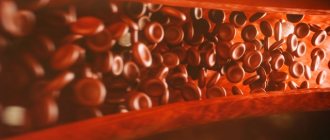Peripheral circulation is a continuous process of blood circulation in small veins and arteries, capillaries, as well as arterioles and venules. A variety of factors lead to impaired blood circulation, including: tumors, injuries, heart and vascular diseases, kidney diseases, metabolic disorders, etc.
Signs of poor circulation may include: pain in the legs, swelling, discoloration of the limbs, headaches, hearing problems, imbalance, numbness in the limbs, etc.
Treatment of poor circulation
When blood circulation is impaired, the following diseases occur:
- arterial and venous hyperemia
- thrombosis
- ischemia
- stasis
- embolism
- varicose veins
- Raynaud's disease
For treatment, it is necessary to accurately determine the cause and, depending on it, prescribe medication. For acute problems, surgery may be required. In addition, treatment must be combined with proper nutrition (eating foods low in fat and salt), giving up bad habits (smoking and alcohol) and undergoing special procedures to improve blood flow (vibration therapy, electromagnetic therapy, etc.).
Symptoms of pathology
Circulatory disorders can form in any organ, but the most significant lesions occur in the myocardium, brain and kidney tissue, as well as in the vasculature of the lower extremities.
Heart
In the heart muscle, the predominant type of microcirculation disorder is ischemia. It leads to a decrease in myocardial contractility. Clinical manifestations are angina attacks, heart attack and sudden cardiac arrest. Can lead to fatal complications or the formation of chronic failure.
The first signs of ischemia development:
- general weakness;
- the occurrence of shortness of breath and palpitations with minor exertion;
- poor tolerance to physical activity;
- minor or moderate pain, tingling in the heart area;
- decreased performance.
Brain
With an acute cessation of brain nutrition, a stroke is formed. Gradual blocking of arteries against the background of atherosclerosis, hypertension, osteochondrosis leads to stagnant processes and swelling of the brain tissue with foci of necrosis. This provokes the development of dyscirculatory encephalopathy with the following symptoms:
- forgetfulness,
- disturbance of the emotional background,
- decreased ability to cognition,
- dizziness,
- headache,
- difficulty coordinating movements,
- unsteadiness when walking,
- weakness in the limbs.
Cerebral ischemia (impaired microcirculation)
Kidneys
Disorders of microcirculation in the renal tissue occur during acute cessation of blood flow (acute failure) or as a result of chronic progressive processes. The latter are much more common and accompany:
- hypertension,
- diabetes,
- autoimmune diseases,
- pyelo- or glomerulonephritis.
Acute renal failure
In these diseases, capillary-trophic disorders develop more slowly than in acute ones, their manifestations can be erased: general weakness, headache, increased blood pressure, frequent urination at night, swelling under the eyes and on the ankles in the morning.
Lower limbs
Common causes of microcirculatory disorders in the legs are:
With thrombosis, tissue nutritional disturbances can occur suddenly. Its symptoms include severe pain, swelling, pallor or cyanosis of the skin. Chronic changes are characterized by a slow increase in these manifestations and a decrease in sensitivity.
With diabetes, patients note constant chilliness of the legs, a crawling sensation, numbness, loss of reaction to cold and heat, and microtraumas . Often microcirculatory disorders contribute to the development of fungal infections on the feet, ingrown nails, cracked heels and the appearance of long-term non-healing ulcers.
Medicines to improve blood circulation
The following groups of drugs are used to improve blood circulation:
1) Drugs that improve microcirculation - this group of drugs acts on the vessels of the microcirculation. As a result, the vessels dilate and the blood becomes less viscous. As a rule, drugs of this group are used for circulatory disorders due to various diseases (diabetes mellitus, atherosclerosis):
2) Prostaglandin E1 drugs - drugs in this group have a positive effect on microcirculation and blood flow, and also have a hypotensive effect: vazaprostan
3) Calcium channel blockers are mainly used to improve blood circulation in the brain. Helps improve vascular microcirculation and limit damage to brain tissue. These include:
- cinnarizine
- logmax
- nafadil
- nimotop
- cinnasan
- brainal
- norwax
- arifon
- cordipin
- phoridon
- Nifecard
- cordafen
4) Low molecular weight dextran preparations - drugs of this group have a positive effect on blood fluidity by attracting additional volumes of blood from the intercellular space. These include:
- rheomacrodex
- hemostabil
- rheopolyglucin
5) Myotropic antispasmodics - this group of drugs dilates blood vessels and relaxes smooth muscles. Myotropic antispasmodics show high effectiveness in cerebral vascular spasms:
6) Herbal medicines are preparations that are created on the basis of plant materials. Herbal medicines show high effectiveness in cerebrovascular diseases, as well as in obliterating atherosclerosis and endarteritis. These include:
7) Alpha adrenergic blockers - drugs of this group contribute to better blood supply to peripheral tissues. These include:
 Ganglion blockers - these drugs improve blood circulation in the lower extremities and also have a pronounced hypotensive effect (lower blood pressure):
Ganglion blockers - these drugs improve blood circulation in the lower extremities and also have a pronounced hypotensive effect (lower blood pressure):
9) Bioflavonoids are substances of plant origin that increase blood flow and improve the condition of blood vessels:
10) Dopamine receptor stimulants - this group of drugs acts on dopamine receptors, which, in turn, leads to vasodilation. Improves blood circulation in the lower extremities - pronoran.
Medicines
Modern medicine has a large arsenal of medications that can thin the blood. Therapy to normalize its rheological properties is prescribed by a doctor after establishing the cause of the pathology, identifying contraindications and the optimal dosage.
Increasing the maximum permissible dose can cause life-threatening bleeding, so self-medication is unacceptable.
Tablets are prescribed for the prevention of thrombus formation in varicose veins, coronary heart disease, especially after myocardial infarction, during complicated pregnancy and in the postpartum period. In case of acute conditions, when it is necessary to quickly dissolve the formed clot, intramuscular injections and intravenous drips are used.
Blood thinners are divided into 2 groups.
Anticoagulants are a group of drugs that reduce fibrin synthesis and the ability to form blood clots:
- direct action (fast but short therapeutic effect) - heparin;
- indirect action (slow effect on blood coagulation factors, long-term therapeutic effect) - phenylin, syncumar, warfarin.
Antiregents are a group of drugs that prevent platelet aggregation (sticking together) and the formation of clots:
- aspecard,
- cardiomagnyl,
- aspirin-cardio,
- thromboass,
- chime,
- ticlopidine.
Cardiomagnyl contains acetylsalicylic acid and magnesium, which helps thin the blood and normalize myocardial function
The active ingredient in antiplatelet agents is acetyl acid (aspirin), which effectively prevents blood clots, thereby improving blood flow and reducing the risk of complications. In modern drugs it is contained in an optimal therapeutic dose and is maximally purified from harmful impurities, which allows the use of drugs in long courses without harm to the gastrointestinal tract (formation of erosions, ulcers, bleeding).
We also recommend: Blood thinners during pregnancy
For example, aspirin is prescribed for the prevention of myocardial infarction, stroke, pulmonary embolism under constant monitoring of the blood coagulation system and under the supervision of the attending physician. Recommendations for taking medications containing medicinal substances include:
- taking pills regularly, occasional treatment is not effective;
- medications must be taken in the evening, when the risk of blood clot formation is especially high;
- prescribing medications after meals to have a gentle effect on the mucous membrane of the digestive tract.
To prevent blood thickening and at the initial stages of the pathological process, biologically active additives (BAS) containing natural ingredients are prescribed. The most popular products are based on dihydroquerticin, an organic extract from Daurian larch. Capilar and Flavit are recommended to be taken in courses of 30-40 days while following a therapeutic diet. In addition to thinning the blood, the drugs help strengthen the immune system, have an anti-inflammatory effect, and prevent the development of tumors and atherosclerosis.
Indications for the use of drugs that improve blood flow
Changes in the normal functioning of any organ are caused by various reasons. Poor circulation in the legs is indicated by:
- increased fatigue of the limbs;
- swelling;
- cramps during night sleep;
- vascular changes (formation of nodes);
- feeling of constant coldness in the legs;
- the appearance of a vascular network.
Factors that influence changes in blood circulation:
- hypertonic disease;
- diabetes;
- obesity;
- sedentary lifestyle;
- excessive consumption of fatty, sweet foods;
- bad habits.
The doctor can prescribe treatment for the patient based on the results of the tests obtained.
If the symptoms of an imbalance in the functioning of the circulatory system are persistent and appear for a long time, it is necessary to seek qualified help. If there are medical indications, based on the examination and test results, the doctor may prescribe medication to improve blood circulation in the legs.
Evaluation of indicators
The main characteristics of hemodynamics in the body are:
- Stroke volume is the amount of blood that enters the vessels when the heart contracts; its norm is 70 ml.
- Ejection fraction is the ratio of systolic ejection in ml to the residual blood volume at the end of diastole. It is about 60%, if it decreases to 45, then this is a sign of systolic dysfunction (heart failure). If it falls below 40%, the condition is considered critical.
- Blood pressure – systolic from 100 to 140, diastolic from 60 to 90 mm Hg. Art. Any reading below this range is a sign of hypotension, while anything higher is indicative of hypertension.
- Total peripheral resistance is calculated as the ratio of mean arterial pressure (diastolic and one third of pulse) to blood output per minute. Measured in din x s x cm-5, the normal range is from 700 to 1500 units.
Data on the state of hemodynamics can be obtained by ultrasound of the heart with Dopplerography and pressure measurement with a tonometer.
To assess rheological parameters, determine:
- Red blood cell content. Normally, it is 3.9 - 5.3 million/µl; it is reduced in cases of anemia, destruction (hemolysis), and tumors. High levels occur with leukemia, chronic oxygen deficiency, and blood thickening.
- Hematocrit In healthy people it ranges from 0.4 to 0.5. Increased with heart defects, breathing problems, kidney tumors or cysts, and dehydration. Decreases with anemia and excessive fluid infusion.
- Viscosity. About 23 mPa×s is considered normal. It increases with atherosclerosis, diabetes mellitus, diseases of the respiratory and digestive systems, kidney and liver pathologies, taking diuretics and alcohol. Decreases with anemia and intense fluid intake.
Efficiency
There are comments to the text, you can read them
Poor blood circulation in the legs depends, first of all, on lifestyle. You can achieve results in improving the condition of blood vessels if you use all the methods and methods together. Stop smoking and drinking alcohol, lose weight, exercise, eat right, wear comfortable shoes and underwear - this is a list of actions that must be performed simultaneously with the use of drug therapy.
Very important! Andreeva E.: “I can recommend only one remedy for the quick treatment of varicose veins” read more.
If pathological changes in the blood vessels of the legs caused by circulatory disorders in the lower extremities are irreversible, medications and tablets, without surgical intervention, will not become a panacea.
General contraindications for use
Angioprotectors are prescribed by a phlebologist, cardiologist, and angiosurgeon. The doctor must take into account the general condition of the person and the presence of chronic diseases.
The drugs should not be used for:
- individual intolerance, hypersensitivity to the components of the drug;
- inflammatory processes of the gastrointestinal tract in the acute stage;
- Medicines are not prescribed to children under 18 years of age.
External agents should not be used for infectious dermatological pathologies or allergies. The drugs are not applied to wounds, burns, or trophic ulcers that do not heal for a long time.
Angioprotectors should not be taken simultaneously with Ritonavir, Erythromycin, Itraconazole, Ketoconazole, Clarithromycin.
Types of drugs
Medicines that improve blood circulation can be for external and internal use. Applying ointments, creams, balms, powders to the surface of the skin helps eliminate inflammation, relieve cramps, increase the tone of blood vessels in the legs, and relieve swelling. Medicines moisturize, soften, and restore elasticity to the skin. Taking the medicine will help improve blood circulation.
Pharmaceutical preparations of low molecular weight dextran
The spectrum of action is aimed at increasing blood fluidity in the vessels of the legs by attracting additional volume from the intercellular space. These include the following:
- "Reopoliglyukin";
- "Reomacrodex".
Return to contents
Angioprotectors
Prescribed to strengthen the elasticity of the walls of blood vessels and their permeability, increasing metabolic processes and microcirculation. This group includes:
Calcium preparations
Drugs from this group are aimed at comprehensively improving the functioning of the entire nervous system, including the system of blood vessels of the lower and upper extremities, which includes:
Antispasmodics
Promote increased blood supply to tissues, help expand the lumen of blood vessels, and are effective for spasms and pain in the legs. These include:
Natural based products
They can be used either independently or in combination with synthetic products. Basic tablets:
Vitamins for blood vessels
Strengthening veins and arteries is also useful with the help of vitamin complexes. For normal functioning of the cardiovascular system, vitamins P, B, C are necessary. Microelements include fatty acids, calcium, magnesium, Omega-3, zinc, copper. Collectively, these substances are contained in vitamin complexes, which are called “Ascorutin”, “Neuromultivit”. Vitamins for leg blood vessels are considered an effective addition to therapy.
Vasodilators for the hands
In recent years, vascular diseases have become increasingly common.
Due to blockage of the veins, deaths or disability are common. Correctly chosen treatment methods using effective medications will help you get rid of these problems. Vascular medications to improve blood circulation in the legs should only be prescribed by a specialist.
This is how you can achieve good results without harm to your health. We will talk about the types of such drugs and their effect on the human body in this article.
Classification of funds
Due to vasoconstriction, various pathologies can develop in the cardiovascular system, limbs and other organs. Vasodilators not only prevent destructive changes, but also help to quickly restore blood circulation and damaged tissues that have been exposed to hypoxia.
The most convenient and informative is the classification of drugs according to their mode of action. The following drugs have the fastest vasodilating properties:
- Nitric oxide. Once in the bloodstream, the free radical instantly relaxes the muscles. The effect of this substance is short-lived, but very effective. It allows you to relieve vascular spasm, for example, during angina, in a short time, restore blood circulation and avoid a heart attack. Medicines that contain this substance: isosorbide dinitrate, nitroglycerin, nitrong-forte.
- Magnesium sulfate. Reduces the mobile activity of calcium ions, which are conductors of antispasmodic signals. Pushes them out of the space between cells. Reduces the excitability of adrenergic receptors, which also stimulate muscle contractile activity. When injected into a vein, it quickly creates a relaxing effect. The action lasts approximately half an hour.
- Antispasmodics. These include drugs that simultaneously act on the circulatory system and smooth muscle tissue throughout the body. The time of their therapeutic effect is approximately 2 to 6 hours. It is based on the inactivation of an enzyme that stimulates smooth muscle contraction. Drugs of this type include: apressin, no-spa and papaverine hydrochloride.
Medicines from the third group stabilize blood circulation and prevent spasm of veins and arteries. Their scope of influence extends to blocking enzymes or receptors that enhance muscle contraction.
Substances acting on the PNS
Drugs that eliminate circulatory disorders of the lower extremities include ganglion blockers, sympatholytics and α-adrenergic blockers. The first remedies affect the sympathetic nodes: the solar or deep plexus of the heart.
List of effective drugs for improving blood circulation in the extremities:
The active ingredients contained in these medications work well for circulatory disorders caused by pathologies of the nervous system (Raynaud's disease, endarteritis, acrocyanosis).
Adrenergic blockers are substances that, when combined with adrenaline and norepinephrine, block their vasoconstrictor effect. Thanks to this, blood circulation in the body improves. This group includes the following medications:
- Phentolamine, Prazosin, Terazosin;
- Vasobral, Nicergoline, Anavenol.
The last three drugs are used for varicose veins and complications of diabetes mellitus (angiopathy). These substances are not exactly vasodilators, since they act in different directions - they increase the tone of the veins and dilate the arteries. Other drugs are effective for nervous pathologies with circulatory disorders, as well as in the treatment of legs affected by atherosclerosis.
Vasodilators
Vasodilation is a medical term used to describe the decrease in smooth muscle tone in the walls of blood vessels. The substances that are used for this are called vasodilators. This group includes many vasodilator drugs with different mechanisms of action on the circulatory system.
Calcium antagonists
For the normal functioning of calcium channels (CC), in addition to Ca, catecholamines (adrenaline and norepinephrine) are needed, which activate them.
There are several types of CKs, but calcium ion antagonists act only on slow CKs (L-type), which are found in smooth muscle tissue.
Calcium channel antagonists are available in various chemical compounds. In addition to lowering blood pressure, they also have the following effects:
- Regulate heart rate.
- They have a good effect on blood circulation in veins, arteries and capillaries.
- Reduce mechanical stress in the myocardium, thereby improving blood circulation. The supply of tissues with oxygen and nutrients is also enhanced.
- Reduce the likelihood of blood clots in arteries and veins.
The most popular calcium antagonists are the following drugs: Nifedipine, Amlodipine, Felodipine. They help reduce the tone of the walls of the circulatory organs and prevent their sharp contraction (spasm).
Alpha blockers
α-blockers block the adrenaline and norepinephrine receptors present in the vessels, preventing them from interacting with these hormones, which can cause significant vascular spasm. This group includes:
- Nicergoline – improves blood circulation, prevents platelet aggregation and thrombus formation. It has a dual effect: it promotes the dilation of arteries and increases the tension of veins (healthy and affected by varicose veins). The medicine is indicated for use in vascular diseases associated with diabetes.
- Phentolamine - dilates blood vessels, relaxes muscles, and increases blood supply to tissues. For the treatment of venous and arterial circulation disorders, treatment of poorly healing wounds, frostbite, bedsores and in the initial stages of atherosclerotic gangrene, doctors recommend this drug in the form of injections and tablets.
If there is a blockage of a vessel with an atherosclerotic plaque, then using vasodilators is useless; surgical treatment is required.
RAS inhibitors
These substances affect arteries and veins. They have a positive effect on the endothelium, reduce platelet aggregation, and inhibit the development of atherosclerosis. These medications include: Enalapril, Lisinopril, Ramipril, Losartan. They have shown good results in the treatment of atherosclerotic pathologies of the legs and intermittent claudication caused by the same cause.
Biogenic stimulants
Medicines belonging to the group of vasodilators for the treatment of lower extremities. Their action is based on substances of animal origin. These medications dilate the arteries of the legs, accelerate blood circulation and improve tissue metabolism.
Solcoseryl
The medicine was made on a natural basis (an extract from the blood of calves freed from protein). The drug is able to increase metabolism in tissues, accelerate the supply of oxygen to the muscles of the limbs, dilate blood vessels and thereby improve blood circulation. Prescribed by doctors in the form of injections.
Actovegin
Its basis is the same as the previous drug. Thanks to the substances it contains, blood circulation improves, the vessels of the lower extremities dilate and ulcers and wounds quickly heal.
Comparative review of vasodilators
The sphere of influence of vasodilating elements is extensive. They are used in the treatment of various pathologies of peripheral circulation:
- varicose veins;
- with atherosclerosis;
- angiodystonia.
Below we consider the most commonly prescribed drugs by doctors.
Galidor
Myotropic antispasmodic with pronounced vasodilating effect. Available in tablets and solutions for intramuscular and intravenous administration. The active substance is bencyclane fumarate. Prescribed for the treatment of diseases of the peripheral circulatory organs, chronic pathologies of the arteries and to relieve spasms in systems and tissues.
There are a number of contraindications, so the product should be used only after the recommendation of a specialist.
Vinpocetine
This synthetic drug restores impaired blood circulation. The active ingredient is vinpocetine.
It has antioxidant, antiepileptic and neuroprotective effects, and also dilates blood vessels and relieves inflammation.
Prescribed for the treatment of many vascular diseases, including impaired motor activity associated with cerebrovascular insufficiency.
Vinpotropil
A nootropic combination drug that also has vasodilating properties. It is used for cerebrovascular insufficiency, prevention of migraines, Parkinson's disease of vascular etiology and other pathologies of the blood supply to the brain, and as a vasodilator for the legs it is used only as part of complex therapy as prescribed by a doctor.
The drug Warfarin-OBL
The active substance is warfarin. This drug is indicated in the treatment and prevention of thrombosis and thromboembolism. It is an indirect anticoagulant. The decrease in coagulability does not occur due to the influence of the drug itself, but due to its pharmacological effects in the body, that is, in a secondary manner.
A doctor may prescribe this drug to prevent or treat blood clots in the circulatory system and congenital thrombophilia (blood thickening).
Vasocket
This medication is recommended by doctors for the treatment of veins. The therapeutic effect of the components extends mainly to the limbs. The main effect is aimed at improving the tone and elasticity of venous vessels and removing areas of blood stagnation. Supporting actions are:
- improvement of lymphatic drainage;
- regulation of general blood circulation;
- decreased vascular permeability;
- regulation of leukocyte qualities.
At the right doses, the drug has a targeted and complex effect on the circulatory system. It has minor contraindications, which the doctor will take into account when prescribing.
Vasobral
A complex preparation containing caffeine and ergot alkaloids. Used for pathologies of cerebral and peripheral blood circulation. The instructions for use say that it is able to increase the tone of veins and restore capillary permeability.
Therefore, it is often prescribed for varicose veins and other circulatory pathologies.
Bilobil
This product contains ginkgo biloba leaf extract. Available in capsules of 40, 80 and 120 mg.
The herbal preparation can improve cerebral microcirculation, slightly dilate blood vessels, increase tissue resistance to hypoxia and reduce the ability of platelets to aggregate.
The drug acts most effectively on the veins and arteries of the arms, legs and cerebral vessels. The active substances of the drug also work as antioxidants.
Traditional medicine
Vascular pathologies of the legs are not an independent disease. This is one of the signs of a poor state of the body. If in the last century problems with joints and blood vessels worried only older people, now even young people are concerned about them. In women, such lesions on the legs occur after childbirth.
Source: https://women-land.ru/varikoz/sosudorasshirjajushhie-preparaty-dlja-ruk.html
General description of drugs
, not only the lower extremities, but also all organs begin to suffer due to lack of nutrition with useful substances . This leads to disruption in their functioning and the development of diseases, including chronic ones.
The drugs described below allow you to disperse blood in the vessels, increase their elasticity, reduce capillary permeability, eliminate swelling and fatigue.
Taking into account the effect of the active substance, all medications are divided into three groups by experts.
- Nitric oxide. Medicines relax muscles, relieving spasms and pain. They help especially well with a high probability of developing a heart attack, angina pectoris and constant spasms of the lower extremities.
- Magnesium sulfate. Reduces the mobility of calcium ions, which eliminates spasms and pain and improves blood flow. The best effect is achieved when administered into the bloodstream through a vein.
- Antispasmodics. They affect smooth muscles throughout the body. This relieves pain, spasm, increases the speed of blood flow, thereby normalizing blood flow.
Only a doctor can select a medicine .
This is necessary in order to take into account the entire medical history and prevent the use of medications if there are contraindications.
Causes of microcirculation disorders
Such disorders are based on processes of damage to the vascular wall, as a result of which its permeability increases. Stagnation of blood develops and the release of its liquid part into the pericellular space, which leads to compression of small capillaries by the increased volume of intercellular fluid, and the exchange between cells and capillaries is disrupted. In addition, in the case when the entire capillary wall is damaged from the inside, for example, with atherosclerosis, as well as with inflammatory or autoimmune vascular diseases, platelets “stick” to it, trying to close the resulting defect.
So, the main pathological conditions that lead to disruption of blood flow in the vessels of the microvasculature are:
- Pathology of the central organs of the circulatory system - acute and chronic heart failure, all types of shock (traumatic, painful, due to blood loss, etc.), myocardial ischemia, venous hyperemia (increased blood volume and its stagnation in the venous part of the bloodstream).
- Pathological changes in the ratio of the liquid and cellular parts of the blood - dehydration or, conversely, an increase in the volume of the liquid part of the blood with excess fluid entering the body, disseminated intravascular coagulation syndrome with increased thrombus formation in the lumen of blood vessels.
- Diseases of the vascular wall:
- Vasculitis (literally, inflammation of blood vessels) - primary hemorrhagic, vasculitis in autoimmune diseases (systemic lupus erythematosus, rheumatoid arthritis, rheumatism), vasculitis in hemorrhagic fevers and bacteremia (sepsis - penetration of bacteria into the blood and generalization of infections),
- Atherosclerosis of large and small arteries, when atherosclerotic plaques are deposited on the inner wall of the vessels, preventing normal blood flow,
- Damage to the vascular wall and attachment of blood clots to it in case of venous diseases - thrombophlebitis and phlebothrombosis,
- Diabetes mellitus, in which there is a toxic effect of excess glucose on the internal lining of blood vessels, develops ischemia (insufficient blood supply) of soft tissues.
Indications and contraindications
You can take the medicine if you have the following pathologies and problems:
- frequent formation of blood clots or a high chance of their occurrence;
- phlebeurysm;
- blood pressure problems;
- diseases of the nervous system, which affects blood vessels;
- atherosclerosis of the lower extremities;
- heart failure;
- injuries to the lower extremities that led to impaired blood flow;
- constant sitting at work with minimal physical activity;
- frequent swelling of the legs, heart problems.
With great caution, medications to improve blood circulation are taken for diabetes.
First, you need to bring your blood counts back to normal and only then proceed with therapy. You should also be careful when prescribing doses and specific medications for people who are experiencing bleeding or are at high risk of bleeding.
Other contraindications should be based on the patient’s medical history and considered in each individual case by a competent specialist.
Anna Poniaeva. Graduated from the Nizhny Novgorod Medical Academy (2007-2014) and Residency in Clinical Laboratory Diagnostics (2014-2016).Ask a question>>
What exercises can you practice if you have insufficient blood circulation?
Specific complexes should be selected by a specialist in exercise therapy to take into account all the features of the clinical situation and the patient’s body.
You can adhere to standard methods of physical activity if there are no health problems. If negative sensations develop, exercises are stopped.
Complex No. 1. We normalize the nutrition of leg tissues.
- Lie down on the floor. Raise your lower limbs. In the air, perform movements like pedaling.
- Calf raises (10 times).
- Scissors.
- Walking on your knees (10-20 steps and a break, 3 sets).
- Bends from a standing position.
Complex No. 2. We restore brain trophism.
- Rotate your head clockwise and counterclockwise (10 in each direction).
- Movement left and right, back and forth. In the same quantity. The pace for both exercises is minimal to avoid damaging your neck.
- Palming. Press on the skull from one side, with your head against your palm. Tension, paradoxically, promotes muscle relaxation and eliminates muscle spasm.
Improving nutrition of the small pelvis is achieved by exercises “bicycle” and “scissors”, as well as deep squats (squatting and back to a standing position).
Attention:
You can't overexert yourself. If desired, you can repeat the complex several times a day, but no more than three. This is an extra burden, there will be no additional benefit from it.
In addition to gymnastics, massage is recommended. Taking into account possible contraindications.
It is impossible to influence the collar area (cervical spine) in case of hernias or high blood pressure. The issue is also resolved at the discretion of the specialist.
The purpose of massage is to eliminate muscle spasm, normalize normal local blood flow, relieve inflammation and strengthen muscles to prevent degenerative changes in surrounding tissues.
Review
Affecting the PNS
A large group of medications that have a positive effect on circulatory problems in diseases of the nervous system .
They combine with adrenaline and norepinephrine, which equalizes the pressure in the blood vessels.
Such medications include:
Vasodilators
This group of medications is aimed at relaxing smooth muscles , thereby restoring normal lumen in the veins and blood vessels. When using vasodilators, blood pressure is normalized and the pulse is equalized.
This group includes two subgroups of medications - calcium antagonists and alpha-blockers.
Calcium antagonists
Drugs in this group normalize the pulse and heart rate. They have a beneficial effect on large and small vessels, reducing increased tension in the myocardial muscle.
Alpha blockers
Medicines in this subgroup directly bind to adrenaline and norepinephrine , thereby eliminating the likelihood of developing serious vasospasm and the ensuing consequences.
RAS inhibitors
This group of medications is aimed at suppressing the development of atherosclerotic plaques , equalizing blood pressure, and improving the nutrition of organ tissues.
This group of medications should not be used in cases of renal artery stenosis, previous angioedema, or an increased amount of potassium in the blood.
Inhibitors are not prescribed during pregnancy and lactation.
Biogenic stimulants
These drugs are of natural origin , they are created from raw materials taken from animals. Biogenic stimulants allow you to dilate blood vessels, improve blood circulation in them, and relieve heaviness and fatigue.
Ointments and gels
They act locally , immediately penetrating the site of the disease.
Thanks to this effect, blood flow in the legs is normalized, fatigue is relieved, and the feeling of heaviness goes away.
Drugs for exacerbation of pathologies
If the disease becomes more complicated and enters the acute stage, the medications mentioned above will be powerless and the prescription of more powerful drugs will be required.
They belong to the classes of thrombolytics and anticoagulants.
These drugs are not used if there is a risk of bleeding, severe pathologies of the kidneys and liver, diabetes mellitus, jaundice, bacterial endocarditis and severe arterial hypertension.
Possible causes of poor circulation in the arms and legs
There are many possible causes, so the first thing you should do is seek medical help.
Once you have identified the root cause, it is time to consider what natural treatment alternatives you can try.
Bad habits such as excessive alcohol consumption, excess caffeine, taking drugs or strong medications, poor posture, nutritional deficiencies and excessive stress can cause problems with circulation in the extremities.
But the reasons may be much more serious.
We're talking about things like peripheral arterial obstruction, arteriosclerosis, Raynaud's phenomenon, coronary artery disease, cardiac arrhythmia, kidney failure, lung disease, diabetes, hypertension, or blood clots.
Other medicines to improve blood circulation
To improve immunity and enhance the beneficial properties of the drugs described above, homeopathic remedies that improve blood flow and blood volume can be used.
Using these medications, it is possible to improve blood circulation not only in the legs, but also in the extremities of the arms and the brain.
This effect of drugs is an additional prevention of stroke and heart attack.
Watch a video with recommendations for improving blood circulation
Methods for measuring blood rheology
To study blood viscosity, instruments called viscometers or rheometers are used. There are currently two common types:
- rotational - blood rotates in a centrifuge, its shear flow is calculated using hemodynamic formulas;
- capillary - blood flows through a tube of a given diameter under the influence of a known pressure difference at the ends, that is, the physiological regime of blood flow is reproduced.
Rotational viscometers consist of two cylinders of different diameters, one of which is nested inside the other. The inner one is connected to the dynamometer, and the outer one rotates. Between them there is blood, it begins to move due to its viscosity. A modification of the rotational rheometer is a device with a cylinder that floats freely in a liquid (Zakharchenko apparatus).
Rotational rheometer
Prophylactic use
For preventive use, you should choose gentle medications ; ointments and gels are best suited for this. They act locally with minimal entry into the bloodstream.
The use of medications is required for people at risk: those constantly engaged in heavy physical labor, those with leg injuries, those suffering from heart disease, and those with static work.
Additionally, the use of the medicine requires proper nutrition and feasible physical activity. The diet should contain a sufficient amount of vegetables, lean meat and a minimum of fatty foods, pickles and canned food.
Drugs that improve blood circulation in the lower extremities are virtually the only option for treating serious disorders such as varicose veins and thrombosis, as well as their prevention.
To quickly obtain a therapeutic effect, you must strictly follow the dosage of medications, undergo a full examination to confirm the diagnosis, and follow other treatment recommendations. With the right approach to therapy, the result will be achieved in 1-2 courses, taking into account the complexity of the patient’s condition.
Instructions from tablet.rf
Only the most current official instructions for the use of medicines!
Instructions for medications on our website are published unchanged in the form in which they are attached to the medications. Peripheral circulation - blood flow in small arteries, arterioles, capillaries, postcapillary venules, arteriovenular anastomoses, venules and small veins. As a result of structural or functional disorders, the following circulatory disorders may occur:
1) Arterial hyperemia - an increase in the filling of tissues with arterial blood. It manifests itself as redness and warming of the skin over the affected area. It develops under the influence of chemicals, toxins, inflammatory products, fever, and allergies. 2) Venous hyperemia - an increase in blood supply to an organ or tissue as a result of obstructed blood outflow through the veins. Manifested by blueness of the tissues. Causes: compression of veins or their blockage, weakening of the heart muscle, obstruction of blood flow in the pulmonary circulation. 3) Ischemia - limited or complete disruption of the arterial blood supply. Causes: compression, blockage or spasm of the arteries. It manifests itself as pain due to the accumulation, under conditions of reduced oxygen supply to the tissues, of under-oxidized metabolic products - inflammatory mediators. 4) Stasis - slowing down and stopping blood flow in capillaries, small arteries and veins. Causes: high or low temperatures, poisoning, high concentrations of table salt, turpentine, mustard oil, microbial toxins. 5) Thrombosis - the formation of blood clots consisting of its elements and preventing normal blood flow. It manifests itself as swelling and cyanosis of the tissues. 6) Embolism - blockage of blood vessels by foreign bodies (microorganisms, drops of fat) or gases.
Clinical forms of peripheral circulatory disorders include obliterating endarteritis, thrombophlebitis and phlebothrombosis, pulmonary embolism, chronic cerebrovascular accidents, varicose veins of the lower extremities, eye diseases of ischemic origin, Raynaud's disease. The complaints that patients make are varied. You should contact a specialist if:
- pain in the legs at the end of the day, when walking or standing for a long time; swelling and cyanosis of the lower extremities; - there are headaches, tinnitus, hearing loss, sleep disturbances, memory disorders, unsteadiness when walking, numbness in the arm or leg, speech disorders, swallowing disorders; - there is chilliness in the hands, pain in the fingers during exertion, whitening of the hands when cooling; - there is a decrease in visual acuity or loss of visual fields.
Means for improving peripheral circulation
Drugs that improve peripheral circulation include: 1) Drugs that improve microcirculation. Angioprotectors. They normalize capillary permeability and improve metabolic processes in the walls of blood vessels. Curantyl (dipyridomole), persantine, trental, flexital, vasonite, radomin, pentoxifylline, doxy-chem. 2) Preparations of low molecular weight dextran. The drugs attract additional volumes of blood from the intercellular space into the bloodstream. Improves blood fluidity. Reomacrodex, reopoliglucin. 3) Preparations of prostaglandin E1. Improves blood flow, microcirculation, and elasticity of red blood cells. Increases blood anticoagulant activity. Dilates blood vessels, reducing peripheral vascular resistance and blood pressure. Vazaprostan. 4) Calcium channel blockers. They improve microcirculation of brain vessels and have a cerebroprotective effect. Used primarily for cerebrovascular accidents. Cordafen, cordaflex, nimotop, stugeron, cinnarizine, adalat, arifon, grindeke, brainal, diacordin, cordipin, cortiazem, logax, lacipil, nafadil, nemotan, nifecard, stamlo, foridon, cinedil, cinnasan, plendil, norvax. 5) Myotropic antispasmodics. Drugs in this group are capable of dilating blood vessels, increasing cerebral blood flow. They are highly effective in treating cerebral vascular spasms. Less effective for vascular damage due to atherosclerosis. The disadvantages of drugs (except for Cavinton) include the phenomenon of stealing - dilation of predominantly intact vessels with a decrease in blood flow to starving areas of the brain. Drugs in this group have the ability to dilate blood vessels, increasing cerebral blood flow. As a rule, they are highly effective for spasms of cerebral vessels, but with the development of sclerotic processes, the ability of cerebral vessels to relax decreases and, consequently, the effectiveness of the action of vasodilators decreases. In addition, these drugs can cause the phenomenon of intracerebral “steal” (absent in Cavinton), when, under the influence of vasodilators, a preferential expansion of intact vessels occurs and blood flow is redistributed in favor of healthy areas of the brain. No-shpa, no-shpa forte, drotaverine, halidor, cavinton, mydocalm, nikoshpan, spasmol, aminophylline. 6) Herbal medicines. Preparations made from natural raw materials. Unlike synthetic drugs, the effect of this group develops more slowly; the therapeutic effect is exerted by a combination of compounds. Effective for diseases of cerebral vessels and obliterating diseases of the lower extremities. Bilobil, tanakan 7) Bioflavonoids. They have the ability to improve blood fluidity by increasing the elasticity of red blood cells. Normalize capillary blood flow. Venoruton, troxevasin, anthoxide. Ganglioblockers. They dilate arterioles, venules, and small veins, thereby achieving a decrease in blood pressure. Promote the redistribution of blood into the vessels of the lower extremities. Dimecoline, camphonium, pachycarpine, pentamine, pyrylene, temekhin, 9) Alpha-blockers. They cause dilation of blood vessels in the skin, kidneys, intestines, especially arterioles and precapillaries, reducing their overall resistance, improving blood supply to peripheral tissues. Sermion, nilogrin, prazosin, pyrroxan, phentolamine. 10) Dopamine receptor stimulants. The vasodilating effect is carried out due to the stimulation of dopamine receptors, which are also present in the vessels of the lower extremities. Increases blood flow in the vessels of the lower extremities. Pronoran.
Normalize capillary blood flow. Venoruton, troxevasin, anthoxide. Ganglioblockers. They dilate arterioles, venules, and small veins, thereby achieving a decrease in blood pressure. Promote the redistribution of blood into the vessels of the lower extremities. Dimecoline, camphonium, pachycarpine, pentamine, pyrylene, temekhin, 9) Alpha-blockers. They cause dilation of blood vessels in the skin, kidneys, intestines, especially arterioles and precapillaries, reducing their overall resistance, improving blood supply to peripheral tissues. Sermion, nilogrin, prazosin, pyrroxan, phentolamine. 10) Dopamine receptor stimulants. The vasodilating effect is carried out due to the stimulation of dopamine receptors, which are also present in the vessels of the lower extremities. Increases blood flow in the vessels of the lower extremities. Pronoran.
Microcirculation: why it worsens, how to improve it, localization of disorders
Everyone knows that the human body functions fully if every smallest cell receives oxygen and nutrients in full. And for this, in turn, good functioning of the microvasculature is necessary - the smallest vessels in the body, or capillaries. It is in them that the exchange of gases and nutrients occurs between the blood and surrounding tissues.
It roughly looks like this - blood cells (erythrocytes) receive oxygen in the lungs, and thanks to an extensive network of vessels in all organs and tissues of the body, they deliver it to each organ. All intraorgan vessels are divided into smaller and smaller arteries, arterioles and, finally, capillaries, in which, thanks to the thinnest wall, gas exchange occurs between the blood and the cells of the organs. After the blood has “gave” oxygen to the cells, it collects waste products (carbon dioxide and other substances), which are delivered to the lungs through small and larger veins and expelled out with exhaled air. In a similar way, the cells are enriched with nutrients, the absorption of which occurs in the intestines.
Thus, the functioning of vital organs - the brain, heart, kidneys, etc. - depends on the state of the liquid part of the blood and the walls of the capillaries themselves.
Capillaries are represented by the thinnest tubes, the diameter of which is measured in nanometers, and the wall does not have a muscular membrane and is most suitable for the diffusion of substances in both directions (into the tissue and back into the lumen of the capillaries). The speed of blood flow and blood pressure in these small vessels is extremely slow (about 30 mmHg) compared to large ones (about 150 mmHg), which is also beneficial for complete gas exchange between the blood and cells.
If, due to any pathological processes, the rheological properties of the blood, which ensure its fluidity and viscosity, change, or the wall of blood vessels is damaged, then microcirculation disturbances occur, which affect the provision of the cells of internal organs with essential substances.
Causes of microcirculation disorders
Such disorders are based on processes of damage to the vascular wall, as a result of which its permeability increases.
Stagnation of blood develops and the release of its liquid part into the pericellular space, which leads to compression of small capillaries by the increased volume of intercellular fluid, and the exchange between cells and capillaries is disrupted. In addition, in the case when the entire capillary wall is damaged from the inside, for example, with atherosclerosis, as well as with inflammatory or autoimmune vascular diseases, platelets “stick” to it, trying to close the resulting defect. So, the main pathological conditions that lead to disruption of blood flow in the vessels of the microvasculature are:
- Pathology of the central organs of the circulatory system - acute and chronic heart failure, all types of shock (traumatic, painful, due to blood loss, etc.), myocardial ischemia, venous hyperemia (increased blood volume and its stagnation in the venous part of the bloodstream).
- Pathological changes in the ratio of the liquid and cellular parts of the blood - dehydration or, conversely, an increase in the volume of the liquid part of the blood with excess fluid entering the body, disseminated intravascular coagulation syndrome with increased thrombus formation in the lumen of blood vessels.
- Diseases of the vascular wall:
- Vasculitis (literally, inflammation of blood vessels) - primary hemorrhagic, vasculitis in autoimmune diseases (systemic lupus erythematosus, rheumatoid arthritis, rheumatism), vasculitis in hemorrhagic fevers and bacteremia (sepsis - penetration of bacteria into the blood and generalization of infections),
- Atherosclerosis of large and small arteries, when atherosclerotic plaques are deposited on the inner wall of the vessels, preventing normal blood flow,
- Damage to the vascular wall and the attachment of blood clots to it in diseases of the veins - with thrombophlebitis and phlebothrombosis,
- Diabetes mellitus, in which there is a toxic effect of excess glucose on the internal lining of blood vessels, develops ischemia (insufficient blood supply) of soft tissues.
What are the symptoms of such disorders?
Blood microcirculation disorders can occur in any organ. However, the most dangerous damage to capillaries is in the heart muscle, in the brain, in the kidneys and in the vessels of the lower extremities.
Heart
Microcirculation disorders in the heart muscle indicate the development of myocardial ischemia, or coronary heart disease. This is a chronic disease (CHD), the danger of which is the development of acute myocardial infarction, often fatal, as well as the formation of chronic heart failure, which leads to the fact that the heart is not able to supply blood to the entire body.
The initial symptoms of impaired blood flow in the myocardium include such signs as increased fatigue, general weakness, poor exercise tolerance, shortness of breath when walking. At the stage when severe myocardial ischemia develops, pressing or burning pain appears behind the sternum or in the projection of the heart on the left, as well as in the interscapular region.
Brain
Disorders of microcirculation in the vessels of the brain appear as a result of acute or chronic disorders of cerebral circulation. The first group of diseases includes strokes, and the second develops due to long-term arterial hypertension, when the carotid arteries supplying the brain are in a state of increased tone, as well as due to damage to the carotid arteries by atherosclerotic plaques or due to severe osteochondrosis of the cervical spine, when the cervical vertebrae pressure on the carotid arteries.
In any case, when the nutrition of brain cells is disrupted, as blood stagnation and swelling of the intercellular substance occurs, microinfarctions of the brain substance are possible. All this is called chronic dyscirculatory encephalopathy (CDEP).
Symptoms of DEP include changes in cognitive and mental functions, disturbances in the emotional spectrum, forgetfulness, especially loss of everyday memory, touchiness, tearfulness, dizziness, unsteadiness of gait and other neurological symptoms.
Kidneys
Microcirculation disorders in the vessels of the kidneys can occur due to acute or chronic processes. Thus, in a state of shock, blood does not flow into the vessels of the kidneys, as a result of which acute renal failure develops. In chronic processes in the kidneys (arterial hypertension, vascular damage in diabetes mellitus, pyelonephritis and glomerulonephritis), disturbances in capillary blood flow develop gradually throughout the entire period of the disease, and are clinically manifested, as a rule, by minor signs - rare urination, nocturia (urination at night). ), swelling on the face.
An acute condition is manifested by the absence of urine (anuria) or a sharp decrease in its amount (oliguria). Acute renal failure is an extremely dangerous condition, since without treatment, the body is poisoned with the products of its own metabolism - urea and creatinine.
Lower limbs
Microcirculation disorders in the vessels of the lower extremities most often develop as a result of acute thrombosis of the arteries or veins of the lower extremities, as well as in diabetic angiopathy - damage to the microvasculature in patients with high blood glucose levels. In addition, disturbances of capillary blood flow in the muscles of the legs and feet occur in smokers due to constant vasospasm of the corresponding vessels and are clinically manifested by intermittent claudication syndrome.
Acutely occurring disturbances in blood flow due to thrombosis are manifested by severe swelling, pale or blue discoloration of the limb, and severe pain in it.
Chronic microcirculation disorders, for example, with varicose veins of the lower extremities or diabetic angiopathy, are characterized by periodic pain, swelling of the feet, and impaired skin sensitivity.
Diabetic foot syndrome deserves special attention. This is a condition that develops as a result of long-term damage to the vascular wall by glucose that is not absorbed by cells, as a result of which macro- and microangiopathy (vascular pathology) develops from minor to severe disorders.
Minor microcirculation disorders in diabetes are manifested by a crawling sensation, a feeling of numbness and coldness of the feet, ingrown nails, fungal infections and cracks in the skin of the soles. Severe disorders develop due to the addition of secondary bacterial flora due to a decrease in local and general immunity and manifest themselves as long-term non-healing trophic ulcers. In severe cases, gangrene of the foot develops and foot amputation may even be necessary.
Leather
It is also worth mentioning microcirculation disorders in the blood vessels of the skin.
In the skin, changes in blood flow and, as a consequence, oxygen supply to cells, occur not only in these pathological conditions, for example, in the skin of the extremities during thrombosis or diabetes, but also in completely healthy individuals during the aging process of the skin. Moreover, premature aging can occur in young people and often requires the close attention of cosmetologists.
So, there are variants of spastic, atonic and spastic-stagnant disturbance of blood flow in the microvessels of the skin:
- The first type is characteristic especially for persons with vegetative-vascular dystonia of the hypertensive type (when there is a tendency to spasm of large vessels with high blood pressure) and is characterized by spasm of small vessels with impaired nutrition of facial skin cells. As a result, a fine-wrinkled type of aging gradually develops - a network of wrinkles is formed throughout the face, even in facial zones. A risk factor for premature aging of this type is smoking.
- The second type is typical for individuals with hypotonic type dystonia (tendency to low blood pressure) and is characterized by the occurrence of microedema in the facial skin, which is externally manifested not by wrinkles, but by a deformative type of skin aging - swelling, spider veins and red spots on the face. A risk factor for premature aging of this type is obesity.
- The third type of changes in skin microcirculation has signs of both options and is more often observed after 40-45 years.
Are microcirculatory disorders dangerous?
Undoubtedly, many microcirculation disorders are dangerous to the health and even life of the patient, primarily if they occur acutely. Thus, disturbances in blood flow in small vessels of the heart muscle that occur during acute coronary thrombosis lead to severe myocardial ischemia, and after a few minutes or hours - to necrosis (death) of heart muscle cells - acute myocardial infarction develops. The wider the affected area, the more unfavorable the prognosis.
In acute thrombosis of the femoral arteries and veins, any delay in terms of medical and surgical intervention can lead to the loss of a limb.
The same applies to persons with diabetic angiopathy and diabetic foot syndrome. Such patients should be taught how to properly care for their feet so as not to lose their legs if a purulent infection or gangrene of the foot develops.
In the case of long-term processes in the body, for example, with microcirculation disorders in the kidneys and brain with hypertension, there is, of course, a dysfunction of the organ, but there is no acute threat to life.
Age-related disorders of blood flow in the microvessels of the skin do not pose any danger to life and health at all, but only cause aesthetic problems.
Which doctor should I contact?
Disorders of blood microcirculation are a common process, so contacting a specific specialist depends on the presence of primary pathology and clinical manifestations.
If you notice frequent or, conversely, rare urination, accompanied by high blood pressure numbers, as well as heart symptoms (chest pain, shortness of breath, heart failure), you should consult a therapist or cardiologist.
In case of swelling, coldness and changes in the color of the extremities (pallor, blueness or redness), it is necessary to visit a vascular or at least a general surgeon. Diabetic foot syndrome is jointly treated by endocrinologists and surgeons.
Disorders of microcirculation of cerebral vessels due to strokes, hypertension or spinal osteochondrosis (the so-called DEP of complex origin) are the prerogative of neurologists.
Correction of impaired blood flow in the skin and associated skin aging is carried out by cosmetologists and dermatologists.
Improving microcirculation, drugs that improve blood flow
Is it possible to somehow improve or restore blood flow in the smallest vessels of the body? The answer to this is yes, at the present stage of development of medicine there are enough means that can regulate the tone of blood vessels, as well as influence their inner wall and the ability of blood to form blood clots, and thus help improve microcirculation.
To improve blood circulation in the lower extremities, the following groups of drugs are mainly used to improve microcirculation:
- Antispasmodics (papaverine, spasmalgon) - relieve the tone of large and small vessels due to their effect on the smooth muscle layer in their wall,
- Angioprotectors and antiplatelet agents (pentoxifylline (vasonite), trental, chimes) help improve metabolic processes in the vascular wall itself, thereby stabilizing its permeability to the liquid part of the blood,
- Biogenic stimulants (solcoseryl, actovegin) have a similar effect as protectors,
- Vasodilators (nifedipine, amlodipine) also weaken vascular tone.
- In acute conditions, drugs are used that reduce blood clotting and prevent further thrombus formation - anticoagulants (heparin, warfarin), antiplatelet agents (aspirin), fibrinolytics (urokinase, streptokinase, alteplase).
It is possible to improve microcirculation in the brain with the help of the same drugs, but the following are more often used - antispasmodics (drotaverine), vasodilators (cinnarizine, vinpocetine), antiplatelet agents (trental, chimes), microcirculation correctors (betahistine), as well as nootropic drugs (piracetam, nootropil ), polypeptides (cortexin, cerebrolysin), gamma-aminobutyric acid preparations (pantogam, phenibut).
As microcirculation correctors for the heart muscle, in addition to these drugs, antioxidants and antihypoxants (Mexidol, Preductal) are highly effective, which not only improve blood flow in the capillaries of the myocardium, but also increase the resistance of its cells to oxygen starvation (hypoxia).
Among the drugs that allow the correction of microcirculation disorders in the kidneys, pentoxifylline, trental and chimes are most often prescribed.
For facial skin, restoration of microcirculation consists mainly in the use of external cosmetic procedures, such as laser treatment of the skin, mesotherapy, installation of mesothreads, plasma lifting, peeling, massage, various masks with retinoids and many other methods of improving microcirculation. All of them are capable of stimulating the functioning of blood vessels in the skin so that the cells receive enough nutrients and oxygen.
In conclusion, it should be noted that blood flow disorders in small vessels are a fairly broad concept that includes a large number of diseases as causative factors. Therefore, only a doctor should look for these factors in a face-to-face consultation, and patients who have some of the symptoms described above should seek help from specialists.
Drugs for pulmonary hypertension
- 1 The effectiveness of drug treatment
- 2 Groups of drugs for pulmonary hypertension and their list 2.1 Slow calcium channel blockers
- 2.2 Anticoagulants
Only a qualified doctor can select effective drugs for the treatment of pulmonary hypertension. The disease develops very slowly and may not bother the patient for a long period, or the symptoms may seem minor. Despite the severity of the disease, with the right approach to treatment it is possible to obtain a positive effect and slow down the progression of the disease.
The effectiveness of drug treatment
This disease is difficult to treat. Drug treatment for pulmonary hypertension is effective, but the degree of effect of drugs directly depends on the stage of the disease.
on
When a disease is detected, the doctor’s first recommendations include the following points:
- Strict diet. Refusal of fried and fatty foods. Limit the amount of fluid consumed to 1.5 liters per day.
- Moderate but regular exercise.
- Vaccination against common diseases to avoid exacerbation of pulmonary hypertension.
- Prevention from pregnancy. Increased stress on the pulmonary artery can cause maternal death.
Treatment of the disease requires complex therapy and constant supervision by the attending physician.
In case of secondary pulmonary hypertension, it is necessary to treat the original disease. The treatment course can drag on for years, because stopping the growth of vascular endothelial cells is associated with great difficulties. Therefore, the treatment is complex, success is ensured by a complex combination of drugs with different spectrum of action.
When treating pulmonary hypertension, all prescriptions should be made by the attending physician. It is strongly recommended that you listen to him, do not refuse hospitalization when indicated, and take all necessary medications. Conventional medications for mild hypertension will not help here: the disease requires a systematic approach and constant medical supervision. The main symptom is a decrease in endurance and the development of heart failure.
Return to contents
Groups of drugs for pulmonary hypertension and their list
| Group of drugs | Why are they being discharged? | Pills, medicines |
| Calcium antagonists | To relax the pulmonary vessels and lung walls |
|
| Thrombolytic drugs | To improve vascular patency, dissolve existing blood clots and prevent the formation of new ones |
|
| Cardiac glycosides | To improve blood circulation, normalize heart function, reduce the risk of arrhythmia |
|
| Prostaglandins | To prevent blood clots and vascular spasms |
|
| Diuretics | To remove excess fluid, reduce swelling, and reduce the load on the heart muscle. |
|
| Mucolytic drugs | To facilitate the removal of mucus during coughing attacks |
|
| To thin the blood | Facilitate blood flow, reduce pressure in the pulmonary artery |
|
Return to contents
Slow calcium channel blockers
Medicines of this group should not be taken by patients with right-sided heart failure.
Slow calcium channel blockers are prescribed for the idiopathic form of pulmonary hypertension, a positive acute test with vasodilators during catheterization of the right heart. In most cases, there is a significant improvement in the condition. Unfortunately, the positive effect persists over a long period of time in only 50% of patients. It is prohibited to use this group of drugs for people with right gastric heart failure, as they have a negative nootropic effect. Therefore, before prescribing these drugs, it is necessary to obtain a positive response to vasolidators during cardiac catheterization. If you do not adhere to this requirement, the likelihood of death increases sharply. The course of treatment is carried out in a hospital. The dose is increased very slowly, and blood pressure levels are monitored to the highest possible level.
Return to contents
